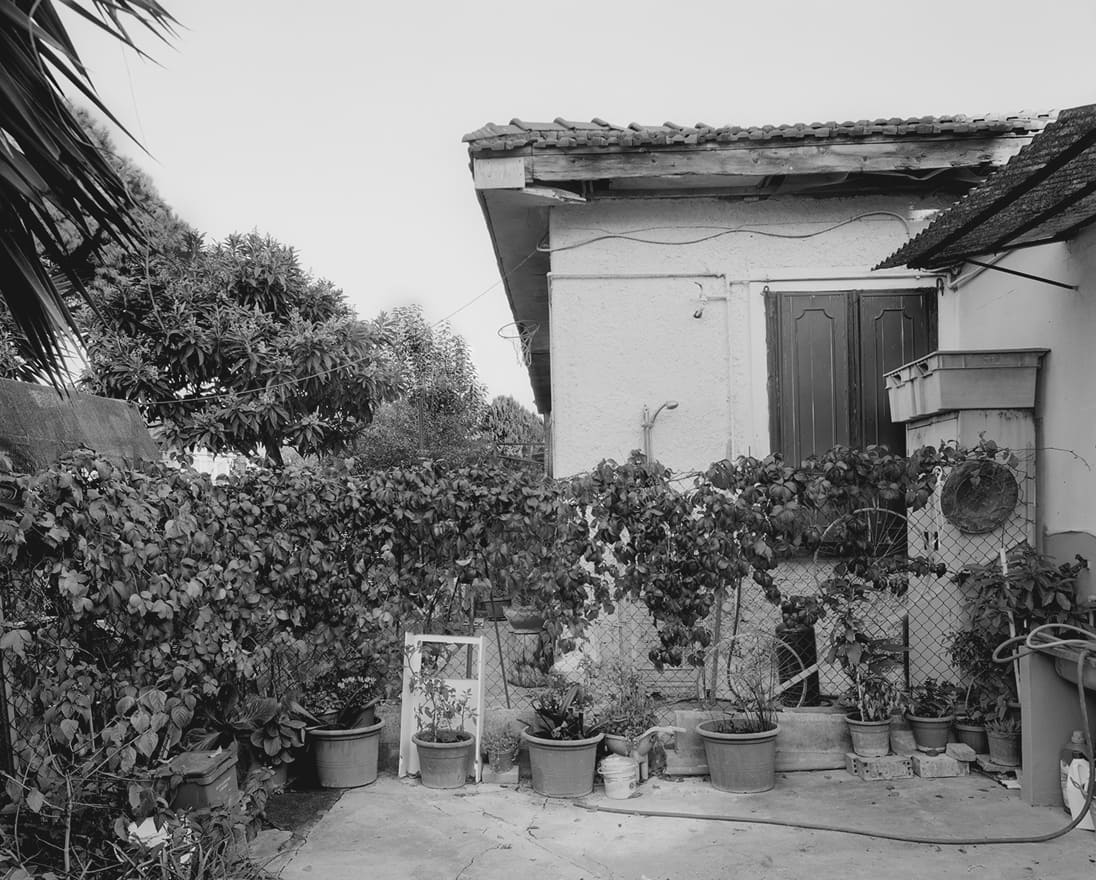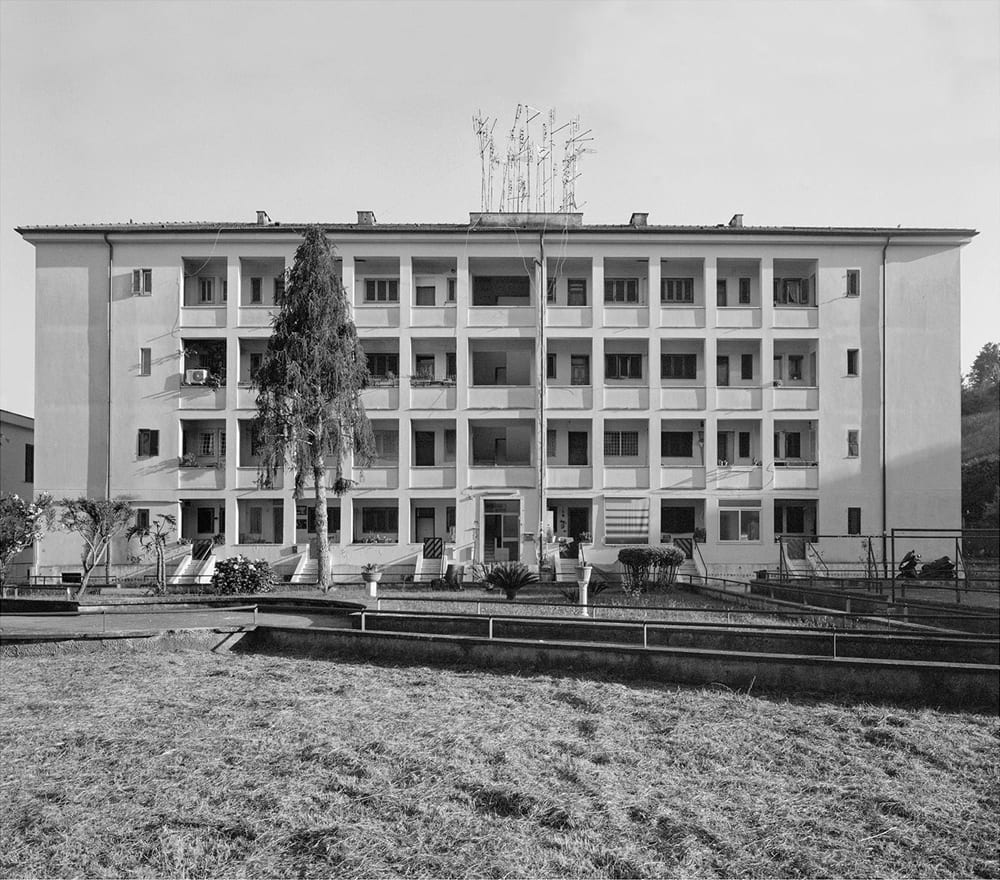Reportage analogico, con banco ottico, nelle 19 borgate ufficiali di Roma
L’indagine fotografica che da vari anni, ormai, conduco a contatto con il territorio e le persone che vivono nelle cosiddette borgate ufficiali di Roma si aggiorna alla luce di recenti studi che stimolano il progetto “Borgate”(1) a esplorare nuovi percorsi, con nuove modalità.
Fondamentali sono stati gli studi di appassionati e insigni studiosi quali Italo Insolera, cui largamente si deve il patrimonio di conoscenze sin qui consolidatosi. Nuove indagini storiche e urbanistiche dimostrano però quanto sia parecchio più articolato e complesso il contesto in cui venne a maturarsi la nascita delle borgate a Roma per volontà del regime fascista.

Acilia.
In particolare, recenti studi(2) hanno capillarmente evidenziato come le precedenti ricostruzioni storiche, sociali e di pianificazione urbana fossero di fatto gravate da consistenti approssimazioni. Tali risultanze sono state possibili grazie anche all’accesso a fonti e documenti sinora inesplorati e/o sconosciuti.

Bufalotta.
La prima incongruenza rilevata, ad esempio, è nel numero stesso delle borgate: ben 19(3) e non 12 come ormai è erroneo sostenere. Nei nuovi studi pubblicati vengono profondamente rivalutati, dimostrandoli, i fatti politici e sociali alla base dei provvedimenti istitutivi delle borgate. Sicché appare oggi abbondantemente riduttivo e impreciso parlare di nascita delle borgate rapportandola unicamente agli sventramenti del centro cittadino di Roma. Non un epifenomeno, tuttavia è stato possibile documentare come tali eventi demolitivi abbiano contribuito solo in residua parte ad alimentare la composizione del popolo delle borgate.

Donna Olimpia.
Evidenze così rilevanti, unite all’esigenza di un approccio allo studio della trasformazione urbana se si vuole ancora più analitico e slow, costituiscono i pilastri della scelta da me adottata di fotografare con approccio analogico, utilizzando pellicola piana per grande formato.
La parola BOrgate, si faccia caso, inizia con quel BO che sembra offrire l’arbitraria ma spontanea possibilità di associarlo alla funzione di acronimo per cui BO = Banco Ottico. È con tale apparato strumentale che ho deciso di condurre la nuova indagine. Come noto, un approccio parecchio complesso, per il quale il livello di dedizione fotografica, analisi e studio risultano amplificati. Ed era proprio ciò che desideravo importare nel codice genetico del nuovo progetto.
Quello che mi sta a cuore è in definitiva la promozione di documento finalizzandolo alla progressiva consapevolezza civica, reattiva, per una città migliore.

Primavalle.
An analogue photography reportage with large format camera in the 19 Rome official borgate (suburbs)
The photographic research, that I have been conducting for several years now in close contact with the territory and the people living in the so-called “borgate” of Rome, is being updated in the light of recent studies that stimulate my “Borgate”(1) project to explore new paths with new methods.
The studies of passionate and distinguished experts such as Italo Insolera were fundamental. However, new historical and urban researches show how much more complex and articulated is the context in which the birth of the borgate has been conceived by the established fascist regime.

Trullo.
In particular, recent studies(2) have highlighted how the previous historical, social and urban planning reconstructions were, in fact, affected by remarkable approximations. These findings were possible thanks also to the access to previously unexplored and/or unknown sources and documents.
The first inconsistency detected, for example, is in the proper number of borgate: as many as 19(3) and not 12 as it is now wrongly said. In the new research are deeply rewritten, demonstrating them, the political and social facts underpinning the planning and building of the borgate. So today it is abundantly reductive and inaccurate to speak about their birth as a consequence linked only to the demolition of the city center of Rome. Not an epiphenomenon, but it has been possible to document how such demolition events have only partially contributed to the composition of the borgate’s population.

Tufello.
Such important evidence, combined with the need for an approach to the study of urban transformation, even more analytical and slow, are the pillars of the choice I have considered in order to photograph using sheet films and large format camera.
It should be noted that the word ‘BOrgate’ begins with ‘BO’ which offers the arbitrary, but spontaneous, possibility of linking it to the acronym function for which BO = Banco Ottico, which is the italian common translation for large format camera. It is with such instrumental equipments that I decided to conduct my renewed research. As known, a very complex approach, for which the level of photographic dedication, analysis and study are amplified. And that was exactly what I wanted to import into the genetic code of the new project.
“Borgate” will be the subject of exhibitions, events, publications to better disseminate and position the photographic culture as a contribution to support the study on urban transformation.
Periodically, I will publish a photographic section with selected images and comments here.
At the end of the day, what matters to me is the promotion of a document aimed at the progressive, reactive, civic awareness, for a better city.

Villaggio Breda.
Note / Notes
1. Pasquale Liguori, Borgate, Ponte Sisto, 2017.
2. Luciano Villani, Milena Farina, Borgate romane. Storia e forma urbana, Libria, 2017.
3. Alle/To borgate Acilia, Gordiani, Pietralata, Prenestino, Primavalle, Quarticciolo, San Basilio, Tiburtino III, Tor Marancia, Trullo, Tufello, Val Melaina vanno aggiunte / must be added Appio, Bufalotta, Donna Olimpia, Fiumicino, Sette Chiese, Teano, Villaggio Breda.







